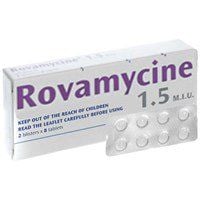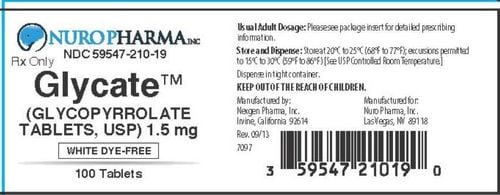This is an automatically translated article.
Kalecin is an anti-infective, anti-parasitic drug, containing the main ingredient Clarithromycin 500mg, prepared in the form of film-coated tablets, packaged in a box of 2 blisters, each blister has 5 tablets. The drug is used in the treatment of infections such as otitis media, acute sinusitis, pneumonia, bronchitis, in the treatment regimen for peptic ulcers caused by HP bacteria...1. What does Kalecin do?
Kalecin is effective in the treatment of infectious diseases thanks to the pharmacological effects of Clarithromycin contained in the drug, in the form of film-coated tablets that make it easy for patients to use, this is a pharmaceutical product of the equitized company. Mekophar Pharmaceuticals Vietnam.
Clarithromycin is a new generation 14C Macrolide antibiotic, semi-synthetic from Erythromycin and the Metoxy substituent at the Carbon-6 position of the Macrolide ring. Therefore, Clarithromycin increases lipophilicity, has a wide antibacterial spectrum, increases drug concentration in tissues, is stable in acidic environment, increases bioavailability of the drug and reduces undesirable effects on the digestive system. . The drug has an antibacterial effect because the drug binds to a specific site on the 50s ribosomal subunit of susceptible bacteria, thereby inhibiting bacterial protein synthesis. Clarithromycin is highly potent, broad-spectrum including gram-positive and gram-negative, aerobic, anaerobic, atypical bacteria including staphylococcus aureus, group A beta-hemolytic streptococci, pneumococci , HI bacteria, gonorrhea, HP bacteria, gram-negative pertussis bacteria, anaerobes Clostridium perfringens, respiratory pathogens Mycoplasma pneumoniae, atypical bacteria Chlamydia trachomatis...
After orally, the drug is rapidly absorbed. Following absorption, Clarithromycin is converted to a first-pass metabolism. The bioavailability of the drug is about 55%. Food in the stomach does not affect bioavailability. The main metabolite is 14-hydroxy clarithromycin. The drug and its metabolites are widely distributed, concentrated in tissues with concentrations higher than those in blood. Approximately 80% of Clarithromycin is bound to plasma proteins. Clarithromycin also penetrates the mucous layer and tissues of the stomach. The drug concentration is higher in the mucous layer when clarithromycin is used concurrently with Omeprazole. Clarithromycin is metabolised in the liver and excreted in the feces via biliary excretion. Metabolites are excreted in the urine. The half-life of the drug is about 3-4 hours after a dose of 250 mg / 2 times / day and increases to about 5-7 hours with a dose of 500 mg / 2 times / day.
2. Indications and contraindications of the drug Kalecin
Kalecin is used in the following diseases:
Diseases of otitis media, tonsillitis, acute rhinosinusitis, acute exacerbation of chronic bronchitis, soft tissue and skin infections. Pneumonia caused by Mycoplasma pneumoniae or Legionella, diphtheria, treatment of the early stages of pertussis, opportunistic infections caused by Mycobacterium bacteria. Helicobacter pylori peptic ulcer disease (drug combination). Do not use Kalecin in the following contraindications:
Patients with a history of allergic hypersensitivity to Clarithromycin, antibiotics of the Macrolide group, adjuvants. The drug should not be used with Ergot derivatives. Contraindicated to use with any of the following drugs: Cisaprid, Terfenadine, Pimozide. Due to the increased concentration of these drugs when co-administered with Clarithromycin. Possible adverse effects such as QT prolongation and arrhythmias including ventricular tachycardia, torsades de pointes, ventricular fibrillation.
3. Dosage and how to use Kalecin
How to use: Kalecin is taken orally, patients should take tablets with a full glass of water, can be used before, during or after meals because food does not reduce the absorption of Kalecin.
Dosage:
Adults: The usual dose is 500 mg orally twice a day for 7 days or Kalecin 500 mg once a day. In severe infections, the dose may be increased to 500 mg twice daily, or a modified-release 1000 mg dose may be used once a day. The treatment lasted 14 days. Children under 12 years of age: It is recommended to use the drug in an emulsion specifically for pediatric patients. Daily dose according to the formula 7.5mg/kg, taken twice a day until the maximum dose of 500mg. The usual duration of treatment is 7-10 days. The regimen for eradicating HP bacteria in patients with duodenal ulcer: The usual dose is 500mg twice daily for 7 days. Co-administration is the proton pump inhibitor Omeprazole 40mg orally twice daily. Patients with renal impairment: No dose adjustment is usually required unless the patient has severe renal impairment (creatinine clearance less than 30ml/min). It may be necessary to adjust the dose to halve the total daily dose.
4. Undesirable effects of the drug Kalecin
Unwanted effects when patients take Kalecin include:
Common gastrointestinal disorders such as nausea/vomiting, dyspepsia, bloating, diarrhea, abdominal pain. Stomatitis, symptoms of glottis, nodules in the mouth. Other side effects include headache, allergic reactions ranging from urticaria and mild skin rash to allergic anaphylaxis and, rarely, Stevens-Johnson syndrome. Taste disturbances may occur, symptoms of loss of color in the tongue may be reversible. There have been reports of transient central nervous system side effects such as anxiety, insomnia, dizziness, psychosis, hallucinations, nightmares, confusion, however a correlation has not been established to date. Cause and Effect. There have been reports of hearing loss with use of the drug, which is usually reversible upon discontinuation of use. Rarely, the adverse effects of mild to severe pseudomembranous colitis are life-threatening. Liver dysfunction is usually self-limiting, such as hepatitis, bile duct stones with or without associated jaundice.
5. Notes when using the drug Kalecin
Notes in the process of taking Kalecin that patients need to pay attention to are as follows:
The drug is mainly excreted by the liver and kidneys. Kalecin should be used with caution in patients with impaired liver or kidney function. Patients should not arbitrarily use the drug without a prescription and take it for a long time. Prolonged and repeated use of the drug can cause the growth of fungi or bacteria that are no longer susceptible to the drug. If superinfection occurs, the patient should be discontinued and appropriate therapy instituted. In a small number of people, because HP bacteria may become resistant to clarithromycin, it is necessary to change the treatment regimen for H pylori causing gastritis. As with other macrolide antibiotics, the use of the drug in patients concomitantly with drugs metabolised by the cytochrome P450 system may result in increased serum concentrations of these drugs. The safety of Kalecin during pregnancy and breastfeeding has not been established. Therefore, Kalecin should not be used during pregnancy or lactation unless more benefit is perceived. Drug interactions: Like other drugs, the use of Kalecin with many drugs will cause interactions, specifically: The drug has not been shown to interact with oral contraceptives. The simultaneous use of Kalecin with oral drugs metabolized by the cytochrome P450 system such as Warfarin, Lovastatin, ergot alkaloids, Triazolam, Phenytoin, Cyclosporin... can increase the concentration of those drugs in the serum. Administration of the drug to patients receiving Theophylline increases blood levels of Theophylline and increases the potential toxicity of Theophylline. The drug may potentiate the effects of Warfarin, so prothrombin time should be regularly monitored in these patients. The effectiveness of Digoxin may be increased when co-administered with Kalecin, it is necessary to monitor the concentration of digoxin in the blood. It may increase the potency of Carbamazepine by reducing the rate of excretion. The drug has been reported to alter the metabolism of terfenadine, causing an increase in its concentration, which is associated with cardiac arrhythmias. Therefore, concurrent use of the drug or with any other non-sedating antihistamines should be avoided. related as Astemizole. Concomitant administration of zidovudine to HIV-infected elderly patients may result in a decrease in steady-state zidovudine concentrations. Doses of Klacid and Zidovudine should be varied by 1-2 hours. Although serum concentrations of clarithromycin and omeprazole may be increased when administered concurrently, no dosage adjustment is required. Increased blood levels of clarithromycin may also occur when co-administered with Maalox or Ranitidine, but no dosage adjustment is required. Above is information about the drug Kalecin. This is a new generation Macrolide antibiotic, which is semi-synthetic, promoting more advantages and effectiveness in the treatment of inflammatory diseases caused by sensitive bacteria. Kalecin is a prescription drug, and patients should not use it without their doctor's prescription. If you have any questions about Kalecin, consult your doctor.













